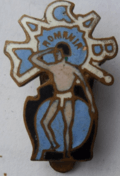Maccabi București
 | |||
| Full name | Maccabi Bucureşti | ||
|---|---|---|---|
| Founded | 15 May 1919 | ||
| Dissolved | 1948 | ||
| Ground | Calea Dudeşti | ||
|
| |||
Maccabi or Macabi Bucureşti, later known as Ciocanul, was a Romanian sport club, representing the Jewish community, akin to the famous Hakoah Vienna. Named after the Maccabees and centering on football competitions, it was the first Jewish side to send a player, the goalkeeper Samuel Zauber, to the FIFA World Cup (at its 1930 edition in Uruguay).
History
Maccabi Bucureşti was founded in 1919 by a Jewish entrepreneur at a time when representatives of the ethnic minorities of Greater Romania established distinctive football sides (another such example was Elpis Constanţa, which was owned by a Greek-Romanian businessman).[1] In 1925, a women's seven-a-side handball team was inaugurated as a branch of the Maccabi club, but, like all Romanian teams of the time, only played exhibition games (usually, as a prelude to competitive football matches).[2]
Before the 1940–1941 season, at a time when Romania adopted antisemitic policies, the club was expelled from official competitions. It reemerged in 1945 at the end of World War II and kept its name before merging with another club to form Ciocanul.[3]
As Ciocanul, the club played in two seasons in Divizia A. In May 1948, it merged with Unirea Tricolor Bucureşti, to create the present-day major Romanian club Dinamo, which was administrated by the Ministry of the Interior.[4] During the 1947–1948 season they remained two separate clubs: Dinamo A (Ciocanul) and Dinamo B (Unirea-Tricolor).[4]
Honours
- Winners (0):, Best finnish: 7th 1946–47
- Winners (1): 1934–35
- Runners-up (1): 1938–39
References
- ↑ Popan, Cosmin (2006-09-06). "Onomastica hazlie a fotbalului" (in Romanian). Cotidianul. Retrieved 2007-07-21.
- ↑ "Cronologie. Geneză – pionierat – afirmare. Perioada interbelică: 1921 – 1945" (in Romanian). Romanian Handball Federation. Retrieved 2007-07-22.
- ↑ Ganur, Tomer (2006-08-10). הקשר הישראלי של דינמו בוקרשט (in Hebrew). Yedioth Ahronoth. Retrieved 2007-06-09.
- 1 2 Popeangă, Marius. "Stadioanele dispărute ale vechilor Bucureşti" (in Romanian). Adevărul. Retrieved 2008-04-28.